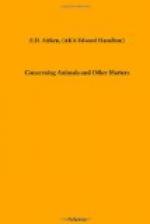But all birds cannot play that part. One is timid, another fastidious, another shy but ingenious. So, in the universal competition for a living, each has taken its own line according to the bent of its nature, and its one tool has been perfected for its trade until it can follow no other. The thrush catches such worms as rashly show themselves above-ground; but an ancient ancestor of the snipe found that, if it followed them into marshy lands, it could probe the soft ground and drag them out of their chambers. For this operation it has now a bill three inches long, straight, thin and sensitive at the tip, a beautiful instrument, but good for no purpose except extracting worms from soft ground. If frost or drought hardens the ground, the snipe must starve or travel. Among the many “lang nebbit” birds that follow the same profession as the snipe, some, like the curlew and the ibis, have curved bills of prodigious length. I do not know the comparative advantages of the two forms, but no doubt each bird swears by its own pattern, as every golfer does by his own putter.
But now behold another grub-hunter, which, distasting mud, has discovered an unworked mine in the trunks of trees. There, in deep burrows, lurked great succulent beetle-grubs, demanding only a tool with which they might be dug out. This has been perfected by many stages, and I have now before me a splendid specimen of the most improved pattern—namely, the bill of the great black woodpecker of Western India, a bird nearly as big as a crow. It is nothing else than a hatchet in two parts, which, when locked together, present a steeled edge about three-eighths of an inch in breadth. The hatchet is two and a half inches long by one in breadth at the base, and a prominent ridge, or keel, runs down the top from base to point. It is further strengthened by a keel on each side. Inside of it, ere the bird became a mummy, was her tongue, which I myself drew out three inches beyond the point of the bill. It was rough and tough, like gutta-percha, tipped with a fine spike, and armed on each side, for the last inch of its length, with a row of sharp barbs pointing backwards. The whole was lubricated with some patent stickfast, “always ready for use.” That grub must sit tight indeed which this corkscrew will not draw when once the hatchet has opened a way.
The swallows and swifts, untirable on their wings, but too gentle to hold their own in a jostling crowd, soared away after the midges and May-flies and pestilent gnats that rise from marsh and pond to hold their joyous dances under the blue dome. Continually rushing open-mouthed after these, they have stretched their gape from ear to ear; but their bills have dwindled by disuse and left only an apology for their absence.




